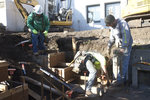When they were built more than a century ago, the concrete stairs leading from Lawrence Street to the Port Townsend Library were designed to be both a physical and transcendent medium.The library was …
This item is available in full to subscribers.
We have recently launched a new and improved website. To continue reading, you will need to either log into your subscriber account, or purchase a new subscription.
If you had an active account on our previous website, then you have an account here. Simply reset your password to regain access to your account.
If you did not have an account on our previous website, but are a current print subscriber, click here to set up your website account.
Otherwise, click here to view your options for subscribing.
* Having trouble? Call our circulation department at 360-385-2900, or email our support.
Please log in to continue |
|


When they were built more than a century ago, the concrete stairs leading from Lawrence Street to the Port Townsend Library were designed to be both a physical and transcendent medium.
The library was established in 1898 by a group of leading community women. By 1913, they had acquired land, secured funding from the city and received a grant from the Carnegie Library Foundation to construct a new building in the Carnegie architectural style of the period, the library website states.
“Carnegie, when he was building libraries oh so long ago, really believed that libraries were exalted halls of knowledge – that they were sacred spaces – and so the stairs were really to signify you were transcending up to a sacred space,” Library Director Melody Sky Eisler said. “The stairs are very symbolic and very important to Carnegie libraries.”
But those stairs have been in a state of disrepair for several years, unusable by the public. That will change as early as December, when construction work to repair them is expected to be completed.
“This is wonderful for us, because we haven’t been able to use that as an entrance, and we will be able to get to do that occasionally after the project is finished,” Eisler said.
Also under construction is the rock wall in front of the historic Charles Pink house, located southwest of the stairs.
The work is being done by Interwest Construction Inc. of Burlington. The cost to replace to the stairs is about $100,000, while the estimated cost for the wall is about $60,000, Eisler said, noting the funding was provided for by the City of Port Townsend and the Port Townsend Library Foundation.
“We are so fortunate that we have a city that believes in preserving and restoring our Carnegie library, and also that we have a library foundation that fundraises and works to support the library in this way with capital projects,” Eisler said.
Construction on both projects began in October.
Efforts are being made to keep both the stairs and stone wall as historically accurate as possible by using existing materials, Eisler said.
“We are doing everything we can to preserve our wonderful Carnegie building,” she said. “They are saving all the rocks, and they are using all the existing rocks to rebuild the wall. And, they are only repairing on the historic Carnegie stairs what would have been failing or was structurally unsafe so they can preserve as much of the historic stairs as possible. This is really exciting to be able to offer this wonderful restoration and preservation of our beloved library.”
More than just infrastructure
While they have a utilitarian purpose, the wall and stairs also have been used as a gathering point for residents who watch the annual Rhody Festival Parade, something that has not been possible for many years, Eisler said.
“The wall and the stairs are very beloved during the Rhody Festival,” she said. “That is when a lot of people line up for the wonderful Rhododendron Parade. This next year they will be much more usable. I think it is going to be really joyful (and) the community is going to be able to appreciate” the restoration efforts.
Pink house
The Pink house was built by Horace Tucker in 1868 and purchased by Charles Pink in 1874. The home remained in the Pink family until 1966. It was purchased by the city of Port Townsend in 1981.
By 1993, the home had suffered from years of neglect and was at risk of being demolished. That year, Bob Little leased the house from the city and restored it to meet both Washington State Archaeological and Department of Interior Guidelines, the G. Little Construction website states.
While the home itself was restored and is now used by the library as a multi-purpose meeting room, the original stone wall that separates it from the street remained in a state of disrepair.
“The wall was basically crumbling ruins,” Eisler said. “They took the wall apart so that they could totally rebuild it and make it structurally sound. It will be capped with a nice limestone cap, which is what it would have had historically.”
The construction crew currently is installing a gabion wall, Italian for “big cage,” behind the location of the stone wall. The gabion wall consists of a chain-link cage filled with rocks designed to prevent erosion.
“A gabion wall is really an ancient form of construction that will support the historic Pink house wall,” Eisler said.
The stone wall will consist of recycled granite stones from the original wall, many of which can be seen strewn about the fenced-off construction zone at the side of the street.
“You can see these are the original rocks to the Pink house wall,” Eisler said. “Part of the wall was sitting here, and we had saved rocks in our public works shops. They have been excitedly waiting to be restored. We have a master mason that is starting to rebuild with them.”
Once finished, the stone wall and staircase “will be really beautiful,” Eisler said.
“I think that is something that is so important, that we hold such a wonderful cultural value in our community for preserving our history,” she said. “It is deeply heartfelt to be a part of this project and to see our history preserved and restored.”